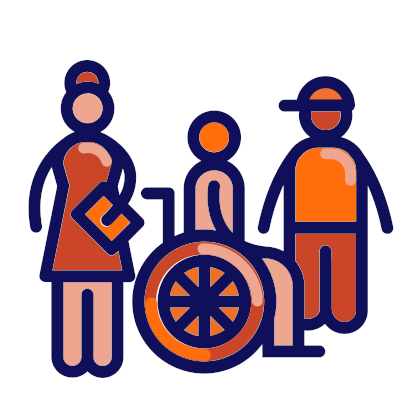Improving well-being at school

Since well-being has many facets, improving students’ well-being in schools requires a whole-school approach, involving both teachers and parents.
Schools should provide lessons focused on the responsible use of the Internet, the need to adopt a healthy lifestyle and how to prevent or cope with health problems, in collaboration with those involved, including health and social services, local authorities and civil society organisations.
Facts & figures
About 60% of school students report getting very tense when they study.[1]
Just over 60% of girls and 40% boys say they feel very anxious about doing tests at school, even when they are well prepared.[2]
Over 70% of parents say they would choose to send their children to a school with below-average exam results if students were happy there.[3]
What is well-being?
Well-being is the experience of health and happiness. It includes mental and physical health, physical and emotional safety, and a feeling of belonging, sense of purpose, achievement and success.
Well-being is a broad concept and covers a range of psychological and physical abilities. Five major types of well-being are said to be:
- Emotional well-being – the ability to be resilient, manage one’s emotions and generate emotions that lead to good feelings
- Physical well-being – the ability to improve the functioning of one’s body through healthy eating and good exercise habits
- Social well-being – the ability to communicate, develop meaningful relationships with others and create one’s own emotional support network
- Workplace well-being – the ability to pursue one’s own interests, beliefs and values in order to gain meaning and happiness in life and professional enrichment
- Societal well-being – the ability to participate in an active community or culture.
Overall well-being depends on all these types of functioning to an extent.[4]
“Having meaning and purpose is integral to people’s sense of well-being. Well-being involves far more than happiness, and accomplishments go far beyond test success.”[5]
Why is well-being important at school?
Well-being is important at school because schools have an essential role to play in supporting students to make healthy lifestyle choices and understand the effects of their choices on their health and well-being. Childhood and adolescence is a critical period in the development of long-term attitudes towards personal well-being and lifestyle choices. The social and emotional skills, knowledge and behaviours that young people learn in the classroom help them build resilience and set the pattern for how they will manage their physical and mental health throughout their lives.
Schools are able to provide students with reliable information and deepen their understanding of the choices they face. They are also able to provide students with the intellectual skills required to reflect critically on these choices and on the influences that society brings to bear on them, including through peer pressure, advertising, social media and family and cultural values.
There is a direct link between well-being and academic achievement and vice versa, i.e. well-being is a crucial prerequisite for achievement and achievement is essential for well-being. Physical activity is associated with improved learning and the ability to concentrate. Strong, supportive relationships provide students with the emotional resources to step out of their intellectual ‘comfort zone’ and explore new ideas and ways of thinking, which is fundamental to educational achievement.
Well-being is also important for developing important democratic competences. Positive emotions are associated with the development of flexibility and adaptability, openness to other cultures and beliefs, self-efficacy and tolerance of ambiguity, all of which lie at the heart of the Council of Europe Reference Framework of Competences for Democratic Culture.
What are the challenges?
One of the challenges of trying to promote young people’s well-being in school is the multi-faceted nature of well-being. There are a number of different types of well-being, all of which need to be promoted to some extent to create an overall sense of well-being in a person. So, it is not possible to improve students’ well-being at school through single interventions or activities. Rather it requires the development of a ‘culture’ of well-being throughout the whole school and the active involvement of the whole staff, teaching and non-teaching, which can be difficult to achieve.
The promotion of well-being may sometimes appear to conflict with other school priorities, such as academic standards. Unreasonably high expectations, a regime of constant testing or an over-emphasis on the importance of academic performance may actually undermine student well-being.
In many cases schools do not have the freedom to make the changes to school life which might most benefit student well-being. They may have little control, for example, over formal examinations and tests, the content of curricula, the length of the school day or the physical school environment.
Nor have schools control over the many out-of-school influences on student well-being. What happens in the home and the family, local communities or social media can have as much, if not more, influence on student well-being as anything in school.
Finally, developing a sense of well-being in students is made all the more difficult when school staff themselves do not have a positive sense of well-being. Well-being at work is strongly related to stress. Stress at work is related to workload, quality of professional relationships, level of autonomy, clarity about one’s role, availability of support and the opportunity to be involved in changes which affect one’s professional life. High levels of stress can lead to demotivation, lack of job satisfaction and poor physical and mental health, which has a knock-on effect on students’ own well-being.
How can schools get active?
Addressing student well-being at school begins with helping students feel they are each known and valued as an individual in her or his own right, and that school life has a meaning and purpose for them. This can be achieved in a variety of small ways, the cumulative effect of which can have a very powerful influence on students’ sense of well-being. These include:
- providing opportunities for all members of the school community to participate in meaningful decision-making in school, e.g. through consultations, opinion surveys, referenda, electing class representatives, student parliaments, focus groups, in-class feedback on learning activities, and an element of student choice in relation to topics taught and teaching methods used;
- developing a welcoming environment where everyone at school can feel supported and safe through access to meaningful activities, e.g. clubs, societies, interest groups and associations dealing with issues of concern to young people, including health;
- taking steps to reduce the anxiety students feel about examinations and testing through the introduction of less stressful forms of assessment, e.g. formative assessment, peer assessment and involving students in the identification of their own assessment needs;
- using teaching methods that contribute to a positive classroom climate and well-being, e.g. cooperative learning, student-centred methods, self-organised time, outdoor activities;
- finding curriculum opportunities to talk about well-being issues with students, e.g. healthy eating, exercise, substance abuse, positive relationships;
- integrating democratic citizenship and education for intercultural understanding into different school subjects and extra-curricular activities, e.g. openness to other cultures in Religious Education, knowledge and critical understanding of human rights in Social Science, empathy in Literature;
- introducing student-led forms of conflict management and approaches to bullying and harassment, e.g. peer mediation, restorative justice;
- improving the physical environment of the school to make it more student-friendly, e.g. new furniture and fittings, carpeted areas, appropriate colour schemes, safe toilet areas, recreational areas;
- encouraging healthier eating by providing healthy options in the school canteen, e.g. avoiding high amounts of sugar, saturated fats and salt;
- working with parents to enhance students’ achievement and sense of purpose in school, e.g. on healthy food, safe internet use and home-school communications.
Individual initiatives like these can be brought together at the whole-school level through a policy development process which ‘mainstreams’ well-being as a school issue. This means giving attention to the potential effects of new policies on individual well-being - of students, teachers and others. Addressing student well-being at school always goes hand in hand with action to protect the health and well-being of teachers and other staff at school.
[1] OECD (2017). PISA 2015 Results (Volume III), p.40. Students’ Well-Being. Paris, France: OECD Publishing.
[3] Cowburn & Blow, ‘Wise up - Prioritising wellbeing in schools’
[4] Psychology Today, January 2019.
[5] Hargreaves & Shirley (2018), ‘Well-being and Success. Opposites that need to attract’.
 Resources on Improving well-being at school
Resources on Improving well-being at school
Address: Prežihova 1, 9250 Gornja Radgona
Country: Slovenia
Project: "Students writing their own school constitution"
 Working language during the project:
Working language during the project:
- Slovenian
 Themes of the Council of Europe campaign “FREE to SPEAK, SAFE to LEARN - Democratic Schools for All” covered:
Themes of the Council of Europe campaign “FREE to SPEAK, SAFE to LEARN - Democratic Schools for All” covered:
- Making children’s and students’ voices heard
- Improving well-being at school
 Competences from the Reference Framework of Competences for Democratic Culture (CDC) addressed and where / how they were integrated:
Competences from the Reference Framework of Competences for Democratic Culture (CDC) addressed and where / how they were integrated:
- Knowledge and critical understanding of the world: politics, law, human rights
- Through the process of writing their class or school constitution, students learn about the content of a constitution, its meaning for citizens, and its role in a democracy.
- Valuing democracy
- Through the process of writing their class or school constitution, students learn about valuing democracy and put into action those key principles of democracy that establish rules for life in a democratic society. By doing so, they develop a better understanding of the role of the Constitution for creating and sustaining democracy, increase their competences in democratic decision-making.
 Target group age range:
Target group age range:
- 11 - 15
 Level of education:
Level of education:
- Primary education
- Lower secondary education
Short description of the project:
Citizens do not always fully understand the meaning and role of the state’s constitution -- one of the key elements of democracy -- because they don’t recognize it as a summary of founding principles, rules and values of democracy, which regulates the functioning of a democratic state and the life of its citizens. It is a founding document in which citizens can learn about their rights, the state structure and functioning, constitutionality and laws, etc. To address this problem, we motivated the students and teachers of our primary school to write a constitution for their class or school.
In order to present and simplify more complex articles in the constitution, we used an illustrated version of a constitution: Constitution in Comics. The main characters, Miha and Maja, present selected articles of the state constitution in a clear and simple way, through examples using everyday situations. During this stage, students learn about the structure and functioning of the government, human rights, basic principles of the democratic decision-making process… They gain an insight into the content, complexity and importance of the document for a democratic State.
In the next step, students compared elements of the State Constitution with procedures used in the school. In this activity, the teacher used questions to direct students to compare and contrast State structure and school structure, State symbols and school symbols, the national anthem and school anthem, the official language of the State and of the school, children's (students') rights and responsibilities, laws in the State and rules in the school, and procedures to change the State Constitution and school Constitution. This activity helped students identify the key elements that should be included in their own class or school Constitution.
During the next activity, students studied documents about Slovenian laws that regulate the Constitution, as well as articles on education that were discussed in the previous activity. Teachers guided students and, when needed, helped them search for corresponding documents (acts and rules on education, school rules, The Universal Declaration of Human Rights, Convention on the Rights of the Child, Act on Founding the School Institution, rules on students' rights and obligations in primary school, a syllabus for the subject of citizen and homeland education and ethics, etc.).
For the next activity, students were divided into working groups. During this time, the working groups narrowed their study to just one field or one clause of the constitution, choosing from general articles, human rights, state structure, constitutionality and lawfulness, or constitutional changes. They read once more the selected articles from the State Constitution and studied the documents that regulate these topics in the school process. They suggested and prepared articles for their class or school constitution. In this activity, the teacher reminded students to bear in mind that their articles had to be based on democratic principles, that they should be aligned with human and children's rights, and that they should be applied equally to all students. Working groups drafted the articles and sent them to the whole project group for adoption.
The draft articles were then revised by all project participants, who had the opportunity to suggest and discuss possible changes. Finally, they voted on the articles. If the majority of the present students voted for the article, it was adopted. The article could be rejected with the possibility to amend it by sending it back to the working group, after which it could be resubmitted for approval. At this stage, the objective was for students to learn and put into practice the key principles of democracy by setting up democratic rules or articles for the group, while modelling democracy during the exercise. They also realized the need to establish the rules one needs for life in a democratic society.
Next, the group wrote the preamble to the Constitution. The students read the preamble as a group, discussed it with the teacher, and learned about the meaning of its content. On the basis of what they read and the discussion, the group prepared a draft of the preamble, in which they stated reasons for writing the school or class constitution and listed its authors.
During the final step, students made decisions about the articles that were previously rejected, rewritten by the group and then sent back for approval. At that point, the class Constitution came into force as an internal document valid for all participants of the school process.
 Aims/objectives
Aims/objectives
- Through the process of writing their class or school Constitution, students learn about the content of a Constitution, its meaning for citizens, and its role in a democracy.
- They also learn about and put into action those key principles of democracy that establish rules for life in a democratic society.
 Expected results/outcomes
Expected results/outcomes
- Students develop a better understanding of the importance of a State Constitution in creating and sustaining democracy, increase their competences in democratic decision-making, and realise the importance of including human rights in the document.
 Changes
Changes
-
The final school Constitution was the result of a project through which students, teachers, parents and representatives of the local community could search for information about general provisions of the school, school rules, students' rights and obligations, rights and obligations of other participants in school processes, and the school structure. The impact of the project and the school Constitution was positive. All participants of the school process accepted the Constitution.
-
The evaluation of the project was carried out in a survey. Project participants and users of the constitution evaluated the content’s appropriateness, everyday usage and role in developing education for democratic citizenship and human rights. The evaluation of the survey showed that the important articles – which were included in the school constitution – are easier to use when they can be found in just one document, as opposed to many different documents. 82% of the student respondents consider the school constitution as very useful in everyday school life. The evaluation can be further carried out on a daily basis by observing the students' behaviour in relation to their promotion of democratic values and human rights, insofar as they live by the articles and values they included in the school Constitution.
 Challenges you face(d)
Challenges you face(d)
-
At the time of writing the constitution, we faced several challenges and barriers. One of the challenges was to present the complex content of the State Constitution, its meaning, and its role to students of this age group. Fortunately, not long before the project, an illustrated State Constitution was published, which made it much easier for students to relate to the document. Students explored the role and meaning of the State Constitution through the process of writing their own Constitution and by accepting and promoting the rules and principles upon which the documents are founded.
-
Another challenge was the need to focus only on the most important documents, among the many that regulate school processes, and to search for possible connections with the State Constitution. At this stage, students needed to be motivated to tackle the large number of documents and information. It was a challenge to incorporate a variety of ways to write and approve articles on democratic principles, since through the very process of writing the constitution, the students developed and internalized the principles and values.
-
Composing the text of the constitution regarding children's (students') rights was also a challenge because the students did not fully understand the importance of ensuring equal rights for all. By focusing on their rights, the students often forgot the imminent connection of their rights to their duties. It was necessary to explain and present the history and content of the most important international documents in relation to human and children’s rights. The aim is to learn the importance of the documents and enable subsequent acceptance of human and children's rights, not only for their own benefit but the benefit of the whole group.
 Time-frame of the project:
Time-frame of the project:
- One school year
 Council of Europe materials on citizenship and human rights education used while preparing or implementing your practice:
Council of Europe materials on citizenship and human rights education used while preparing or implementing your practice:
- Living Democracy - manuals for teachers
- Democratic governance of schools
- Compass
- Compasito
- Human Rights and Democracy Start with Us – Charter for All
 Related schools projects
Related schools projects
Bosnia and Herzegovina
Bulgaria
Croatia
Cyprus
Finland
France
Georgia
Germany
Greece
Ireland
Italy
Lithuania
Malta
Montenegro
Netherlands
Norway
Portugal
Romania
Serbia
Slovenia
Spain
Turkey
Ukraine
United Kingdom







